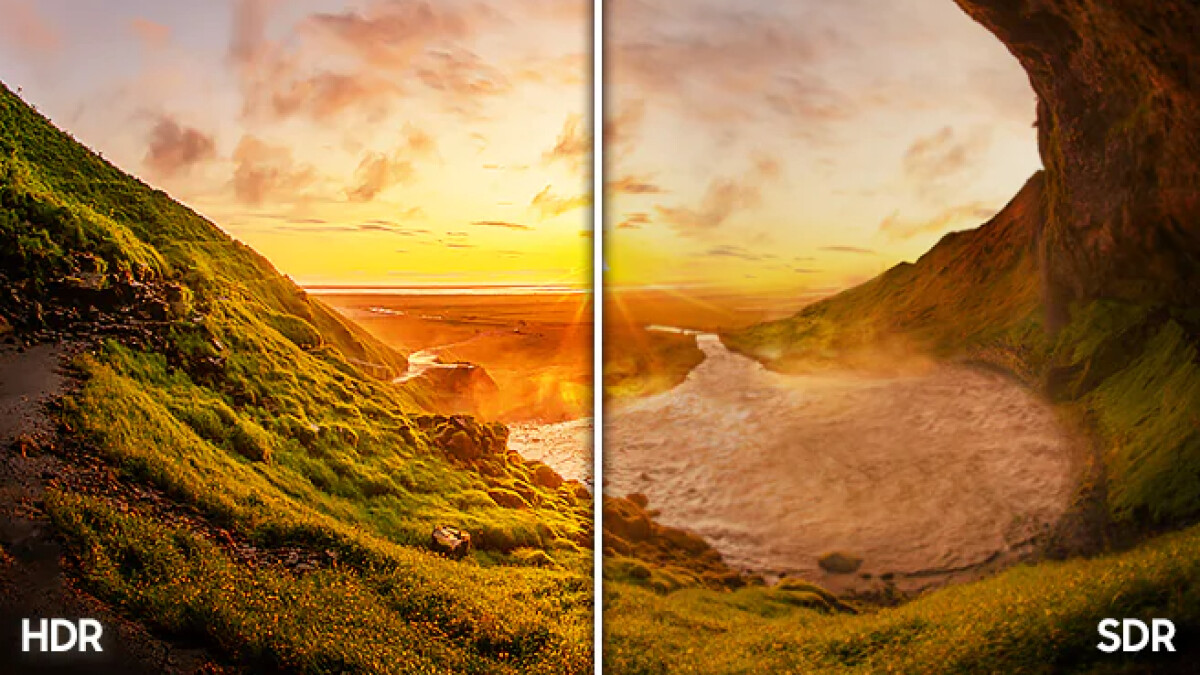HLG is one of the most important HDR standards for television broadcasts. But what exactly is behind the term? Here you can find out more about the use and advantages of the image format.
If your TV supports the HLG standard, you will get a particularly impressive picture quality. (Source: Samsung / Screenshot: Netzwelt)
Modern smart TVs now offer a number of high-quality picture standards. In addition to HDR and its extension HDR10+, this also includes HLG. A must for anyone who wants a real home cinema feeling and wants to see content on the screen in the best quality.
- What is HLG?
Benefits of HLG
Where is HLG used?
Investment in the future?
These new technologies give you impressive picture dynamics when watching TV and streaming and you can immerse yourself completely in the intensive viewing experience on your device. We will explain to you in the further course what exactly is behind “HLG” and where you can find this standard.
What is HLG?
HLG stands for “Hybrid Log Gamma” and is an HDR picture standard developed by the British BBC and the Japanese NHK. The format is used in the TV reception area, such as via satellite or cable, and is capable of displaying both normal quality (SDR) and high quality (HDR) images. The bandwidth space of transmitters is saved by HLG, since SDR images are transmitted with an extended gamma curve, while still recognizing greater contrast and dynamic reception.

The HLG standard was developed specifically for television broadcasting by the broadcasters BBC in Great Britain and NHK in Japan. (Source: BBC / Screenshot: Netzwelt)
Benefits of HLG
The image quality of your content can depend on many properties. This not only includes a high resolution as with 4K televisions or an intense color depth, but also the extended contrast range of your images. This is where the two most important HDR formats HDR10 (PQ) and Hybrid Log Gamma (HLG) come into play.
One of the biggest benefits of Hybrid Log Gamma (HLG) is backward compatibility, which allows content to be broadcast on standard dynamic range (SDR) TVs and HDR devices without the need to process metadata. So your TV doesn’t have to have HDR capabilities to display HLG properly.
With SDR screens, the same color format is used as with UHD resolution (Ultra High Definition). Content in 4K is still played back without loss of quality when watching TV. Streaming providers can also use HLG to save bandwidth and capacity during transmission.
HLG is also characterized above all by an extraordinary contrast range of 1:1,000,000, which makes content appear particularly lifelike and intensive. The difference between black and white is strongly emphasized and even the smallest details in the shadows become visible.
Where is HLG used?
The best-known TV manufacturers such as Sony, LG and Panasonic have been offering Hybrid Log Gamma-compatible 4K HDR televisions in their new model series since 2017, but are increasingly focusing on Dolby Vision in their offered functions. If your smart TV is not up to date, the HLG standard can usually even be supplemented and improved with a firmware update. You can find more information about this from your provider.
One provider in particular relies on the new image standards and supports HDR10+ and HLG: Samsung. Smart TVs such as the Samsung model “Crystal UHD 4K AU7199” from 2021 promise an extended color spectrum and great attention to detail, which are particularly emphasized by these formats.

The Optoma “4K400x” projector is HDR and HLG compatible, which ensures impressive image quality. (Source: Optoma / Screenshot: Netzwelt)
The playback of HLG formats is not only possible for television broadcasts. Modern UHD projectors such as the Optoma model “4K400x” are also compatible with HDR and HLG, which makes the viewing experience on the big screen even richer in contrast and more exciting.
If your smart TV or projector supports picture standards such as HLG and HDR, you will get a particularly high picture quality. However, transmissions of HLG and HDR content are not yet used as a common standard in television. Similar to using 4K resolution. HLG is still not required for streaming either, since the format was primarily created for linear television transmission.
Investment in the future?
So should you get a new smart TV that is HLG compatible? If your device has an HDMI port, with an HDMI 2.0 connection, it is very likely that it is already equipped with HLG. If you have an HDR TV, chances are it will support HLG as well.

The difference between HDR and SDR content is clearly visible. So you can expect better picture quality on TVs that support HLG and HDR. (Source: Samsung / Screenshot: Netzwelt)
Even if you want to buy a new TV set: HLG does not require any outstanding technical requirements, which is why a modern HDR television with HLG format does not have to be expensive. The situation is completely different with Dolby Vision, for example, where you have to reckon with higher costs for the special feature in the picture quality.
If you would like even more help when choosing a modern Smart TV, here are 11 practical tips to help you find a suitable device. Be sure to check out the current TV deals for great discounts.
Don’t miss anything with the NETWORK-Newsletter
Every Friday: The most informative and entertaining summary from the world of technology!
